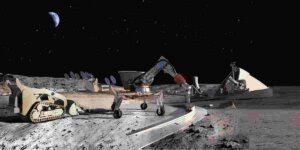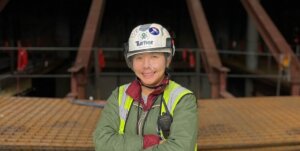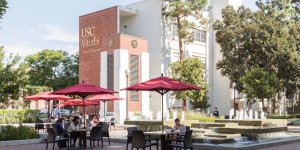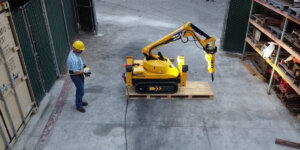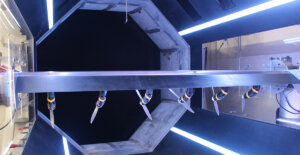University of Southern California researchers are at work on a fundamentally new way to build houses and other structures, funded by a grant from the National Science Foundation.
The process, called “Contour Crafting,” has already won two patents, attracted the interest of nationally known architect Greg Lynn, and won a best paper award at an important recent robotics conference.

Behrohk Khoshnevis with Contour Crafting Machine and wall it built
“The goal is to be able to completely construct a one-story 2000-square foot home on site in one day without using human hands,” says the co-principal investigator on the project, Behrokh Khoshnevis, a professor in the USC School of Engineering’s Daniel J. Epstein department of industrial and systems engineering who is developing the project at the School’s Information Sciences Institute.
The NSF grant will support the scale-up of a system Khoshnevis has been working on for five years, since he had the inspiration for it while smoothing plaster on his house. Contour Crafting builds up shapes in layers by controlling the flow of liquid building materials using two movable, programmable trowel-like tools deployed around a nozzle.
Khoshnevis’s machines can create three-dimensional items in any desired shape — cubes and boxes, bowls or domes, cylinders, cones; cones coming out of boxes, rings or disks, either geometrically regular or free-form. (See illustration, below)
 The materials can be plaster, concrete, adobe, plastic or even wood particles mixed with epoxy into a paste. Guided by computer programming based on analysis of CAD-CAM representations, the Contour Crafting nozzle-and-trowel system molds these materials into shape while semi-liquid. Khoshnevis believes the resources of Information Sciences Institute, a nationally recognized facility specializing in computer research, will help sophisticate the programming and controls.
The materials can be plaster, concrete, adobe, plastic or even wood particles mixed with epoxy into a paste. Guided by computer programming based on analysis of CAD-CAM representations, the Contour Crafting nozzle-and-trowel system molds these materials into shape while semi-liquid. Khoshnevis believes the resources of Information Sciences Institute, a nationally recognized facility specializing in computer research, will help sophisticate the programming and controls.
Khoshnevis’s system grows out of a well-established technology called rapid prototyping. “R-P” systems use computer-controlled head mechanisms to build up or selectively solidify layers of (usually) specialized, exotic materials. Rapid prototyping, as its name indicates, is most typically used to create 3-D models — prototypes — that are then used to create molds for casting or die-casting metal or plastic, rather than to manufacture objects that are themselves used as products.
Contour Crafting, by contrast, is aimed at products, not prototypes. The use of the double trowels to control a continuing flow of material from a nozzle is unique to the Contour Crafting process and allows use of much cheaper and more durable materials, applied in thicker layers with better control.
Contour Crafting can already create larger objects than other rapid prototyping systems. By making the nozzle still bigger and mounting it on a overhead gantry system, a newer 6-cable “Robocrane” system, or even on freestanding, wheeled robotic units, Khoshnevis believes Contour Crafting can erect building-sized structures, layer by layer. The new NSF grant will give him resources to realize this aim.
In the first construction design he hopes to realize, the nozzle begins by creating a hollow wall outline perhaps one foot wide, and one layer (perhaps 6 inches) high, through the entire footprint of the building, external and internal walls alike. (See diagram below)
 On the next pass, it raises the hollow outline by another layer —- while filling in the hollow left in the first pass with more material. Repetition of the process creates a solid cement wall. The gantry system — an overhead beam mounted on two uprights, running on parallel rails — could be used to create a succession of houses in a row, each programmed to have its own design. Speed is limited by how fast each layer dries enough to allow another to be put on top. The system will allows additions to this basic scheme. A robot arm can continually insert coils of steel rebar to make the wall stronger, for example. Creation of hollow conduits, either vertical or horizontal, is easy, Khoshnevis says.
On the next pass, it raises the hollow outline by another layer —- while filling in the hollow left in the first pass with more material. Repetition of the process creates a solid cement wall. The gantry system — an overhead beam mounted on two uprights, running on parallel rails — could be used to create a succession of houses in a row, each programmed to have its own design. Speed is limited by how fast each layer dries enough to allow another to be put on top. The system will allows additions to this basic scheme. A robot arm can continually insert coils of steel rebar to make the wall stronger, for example. Creation of hollow conduits, either vertical or horizontal, is easy, Khoshnevis says.
Adobe is a natural material to use — and the Pasadena- based California Institute of Earth Art and Architecture has already offered a building site for a prototype contour- crafted adobe structure. (See diagram below)Houses or other buildings are hardly the only possible items to construct: a contour crafting unit could equally well build a road in a prepared bed, quickly and automatically.
 The scale-up will be a challenge. “We are talking about much larger machines, much greater volumes of material, and working outdoors in less controllable environments,” Khoshnevis acknowledges. Still, he says, while the practical problems are formidable, “we have a working smaller-scale system and there is no theoretical reason why a larger one won’t work.”
The scale-up will be a challenge. “We are talking about much larger machines, much greater volumes of material, and working outdoors in less controllable environments,” Khoshnevis acknowledges. Still, he says, while the practical problems are formidable, “we have a working smaller-scale system and there is no theoretical reason why a larger one won’t work.”
And work anywhere. A recent Khoshnevis paper proposes a way to use the system to create structures on the moon. Contour Crafting has already attracted interest in the world of industrial design, construction, and architecture. Venice, California-based architect Greg Lynn, whose design for the New York Presbyterian church won prizes and who is part of United Architects, one of the six design teams who submitted semifinal proposals for rebuilding the World Trade Center, calls the possibilities of the process “extraordinary for anyone in the design field. It offers way to close the gap between drawing and construction.”
Lynn has been developing a vision of what he calls “custom designed, mass produced houses, based on computer design tools” for years. Khoshnevis, after reading an article by Lynn on the subject, introduced himself and showed a video of the Contour Crafting process to Lynn’s architectural group.
“Our response was,’here it is,’ ” Lynn recollected. “We knew it it was inevitable that something like this was going to be developed. We had been waiting for someone to take the initiative and do it. ”
The architect said the process not only held the potential of making building faster and freer for architects, but also opened new artistic vistas:
“Architects are now exploring a whole new family of shapes and forms. It’s very difficult to realize these using conventional construction techniques. I also believe that aesthetically there’s a great potential to make things that have never been seen before,” he said.
Khoshnevis recently won a “best paper” prize for his paper setting forth the principles of house-scale Contour Crafting at the 19th International Symposium on Automation and Robotics in Construction, held in September 2002 in Washington D.C.
Khoshnevis’s co-investigator on the NSF grant is veteran robots expert and National Academy of Engineering member George A. Bekey of the USC department of computer science. Another ISI internationally known robotics expert, Engleberger prizewinner Peter Will, is now also collaborating with Khoshnevis.
Published on January 9th, 2003
Last updated on August 10th, 2021




